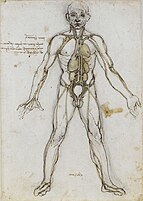
Photo from wikipedia
Background We investigated the composition of the gluteal (gluteus maximus, medius, and minimus) and quadriceps (rectus femoris, vastus lateralis, medialis, and intermedius) muscle groups and its associations with femoral bone… Click to show full abstract
Background We investigated the composition of the gluteal (gluteus maximus, medius, and minimus) and quadriceps (rectus femoris, vastus lateralis, medialis, and intermedius) muscle groups and its associations with femoral bone marrow using chemical shift encoding-based water-fat magnetic resonance imaging (CSE-MRI) to improve our understanding of muscle-bone interaction. Methods Thirty healthy volunteers (15 males, aged 30.5 ± 4.9 years [mean ± standard deviation]; 15 females, aged 29.9 ± 7.1 years) were recruited. A six-echo three-dimensional spoiled gradient-echo sequence was used for 3-T CSE-MRI at the thigh and hip region. The proton density fat fraction (PDFF) of the gluteal and quadriceps muscle groups as well as of the femoral head, neck, and greater trochanter bone marrow were extracted and averaged over both sides. Results PDFF values of all analysed bone marrow compartments were significantly higher in men than in women ( p ≤ 0.047). PDFF values of the analysed muscles showed no significant difference between men and women ( p ≥ 0.707). After adjusting for age and body mass index, moderate significant correlations of PDFF values were observed between the gluteal and quadriceps muscle groups ( r = 0.670) and between femoral subregions (from r = 0.613 to r = 0.655). Regarding muscle-bone interactions, only the PDFF of the quadriceps muscle and greater trochanter bone marrow showed a significant correlation ( r = 0.375). Conclusions The composition of the muscle and bone marrow compartments at the thigh and hip region in young, healthy subjects seems to be quite distinct, without evidence for a strong muscle-bone interaction.
Journal Title: European Radiology Experimental
Year Published: 2020
Link to full text (if available)
Share on Social Media: Sign Up to like & get
recommendations!